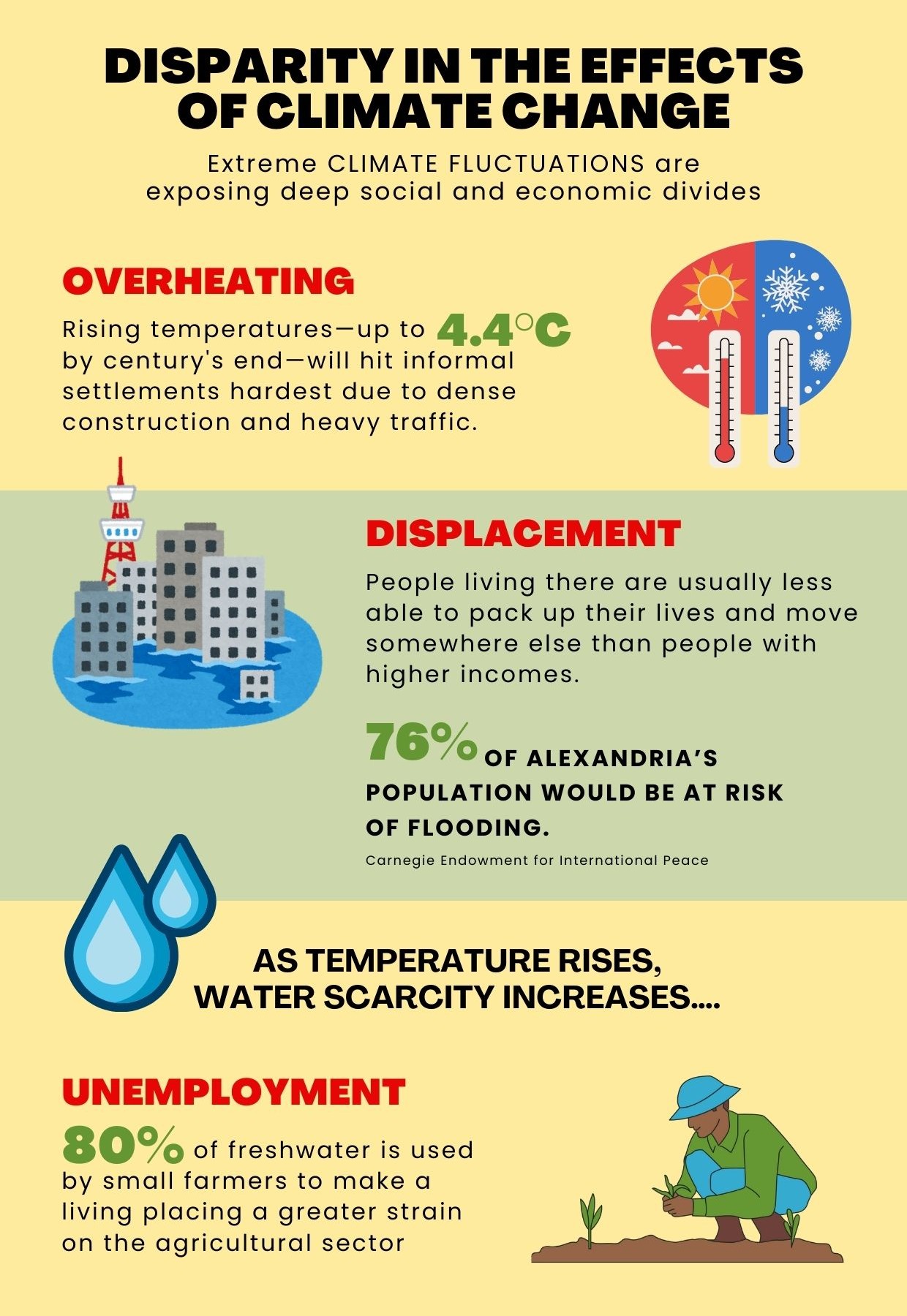- Image Credits: Malak Bassiouny, Malak Elkaddadi and Menna Salah
From foggy mornings to extreme heat waves, Egypt has been witnessing severe weather fluctuations just this month alone. But a factor that often goes unnoticed is how these fluctuations translate into daily living conditions. The truth is: not all of us experience it equally.
The extreme heat, water shortages, and environmental shifts are exposing deep social and economic divides. For some, these changes might mean a mere inconvenience; for others, they threaten livelihoods, health, and basic security.
“People living in informal areas suffer from an intersectionality of risk, as they may have lower incomes, may have a migration background, have lower education levels and less access to information,” said Tina Jaskolski, professor in the department of sociology, egyptology and anthropology at AUC, and instructor of the Environmental Issues in Egypt course.
The Carnegie Endowment for International Peace warns that average annual temperatures could rise to 2.1 degrees celsius by mid-century and 4.4 degrees celsius by the close of the century, with regions like South Sinai and Aswan particularly exposed to extreme heat.
Jaskolski explained that this trend will be more burdensome for people living in informal settlements as these areas are characterized by “condensed construction, high population density and heavy traffic.”
But it’s not just the buildings and traffic, the absence of trees and green spaces in informal settlements also plays a role, further intensifying the temperatures there compared to other parts of the city.
The fact that such underprivileged communities are already facing a combination of both social and economic challenges limits their adaptive capacity to climate change.
“When you take a look at any problem such as the unequal distribution of resources between classes, you will find that climate change multiplies the problem,” said Yasmine Ahmed, a professor in the anthropology department and a Thimar Member, a research collective on agriculture, environment and labor in the Arab world.
For cities like Alexandria, rising sea levels are among the most pressing consequences of climate change. According to the Carnegie Endowment for International Peace, around five percent of its population is already living in areas below sea level. With a one meter rise, 76 percent of Alexandria’s population and 82 percent of the city’s services would be at risk of flooding.
This threat is particularly acute in Alexandria’s underprivileged neighborhoods.
“The houses and roads in certain underprivileged areas in Alexandria are not equipped to survive a rise in sea level. People living there are usually less able to pack up their lives and move somewhere else than people with higher incomes,” said Ahmed.
Beyond coastal areas, Egypt’s agriculture sector is also under threat, raising serious concerns for the country’s food security and economic stability. The Carnegie Endowment reports that approximately 55 percent of the country’s labor force is engaged in agricultural activities, and in 2019, the sector formally employed 21 percent of Egyptian workers.
This sector’s economic weight is undeniable, and that makes it all the more exposed to a shifting climate.
Ahmed explained that unfavorable weather affects the productivity of the harvest, which in turn affects the profits of agricultural businesses. This is a challenge that hits small farmers the hardest, with fewer resources to fall back on.
These challenges are not just environmental, they are deeply tied to longstanding structural inequalities.
The United Nations Development Programme says Egypt could face reduced crop yields, less water, a significant reduction in agricultural production, and either losses of property or higher coastal protection costs. This would lead to an increase in malnutrition and unemployment, and total economic losses by 2060 could be several hundred billion EGP per year.
“There is already unequal access to resources between farmers. There is a sense of favoritism toward big investors when it comes to governmental policies. Climate change leads to a scarcity of resources, which exacerbates the inequality and forces farmers to compete over the resources. This creates grudges between them and destroys the sense of community,” she said.
One of those scarce resources is water. According to the United Nations, Egypt needs at least 90 billion cubic meters of water annually to meet demand. Yet the Nile River, on which the country depends for 90 percent of its water supply, only provides about 55 billion.
As temperatures rise and rainfall patterns shift, water scarcity is likely to deepen, placing even greater strain on the agriculture sector and those who depend on it to make a living.
Jaskolski cautioned that farmers and underprivileged people are most immediately affected.
“Farmers depend on water for irrigation, so agriculture consumes over 80% of freshwater in Egypt,” she added.
“In cities, lower income neighborhoods and informal areas are often less serviced with potable water and may be more frequently affected by water cuts. They struggle more than other neighborhoods to cover rising water bills.”
